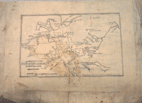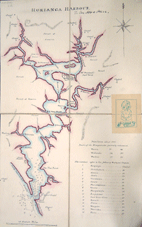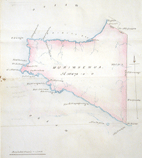Taitokerau
Taitokerau, the Northland (north of the north) region of Aotearoa/New Zealand.

Sketch of the Bay of Islands in New Zealand, c.1828. HM 841.815, Hocken Library.
Following the arrival of the Church Missionary Society in 1814, the establishment of a mission station in Kerikeri in 1819, and Hongi Hika's return from England with some 300 muskets in 1821, major changes were taking place in the Bay of Islands. Local politics became increasingly volatile, as Rangatira (Chiefs) vied with each other to control Europeans and access to their material goods. This sketch of the Bay of Islands was produced during this time.

Map of the Hokianga Harbour, n.d. HM 841, Hocken Library.
In 1823 the Wesleyan Missionary Society joined the Church Missionary Society in the Northern region of New Zealand. Initially a mission station was established at Whangaroa Harbour, against the advice of Hongi Hika and subsequently this station was abandoned in 1827. The Wesleyans were then re-established in and around the Hokianga Harbour in 1828 under the protection of the Rangatira (Chief) Patuone. This map of the Hokianga Harbour shows the number of Wesleyan Chapels in the Hokianga as well as the extent of cultivations in the area.

Sir James Hector, Notes on an expedition through Northland, January-February 1866. Hector Papers, MS 0443-1/38, Hocken Library.
Sir James Hector (1834 - 1907) was a geologist and explorer, and from 1865 was appointed director of the Geological Survey and Colonial Museum in Wellington. He made extensive explorations and geological surveys of both the North and South islands. These two journals contain notes and sketches from expeditions in the Northland district in 1866 and 1874. The name Rawhiti appears on the above sketch. Unfortunately no names appear in the journal notes for the sketch below.

Map of Muriwhenua, n.d. Shortland papers, MS-489/1, Hocken Library.
The name Muriwhenua was recorded in 1793, possibly for the first time by Tuki Tahua, after he was kidnapped and taken to Norfolk Island. The Maori spiritual pathway ends in Muriwhenua at Te Rerenga Wairua (Cape Reinga). The tribes of Muriwhenua see themselves as guardians of this pathway, where all departed souls of Maori must travel to reach their spiritual homeland.


